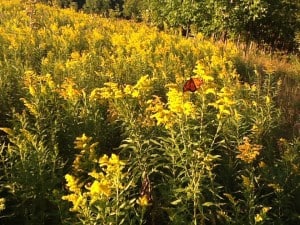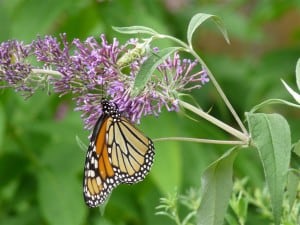The MonarchWatch blog can be viewed here. http://monarchwatch.org/blog/
As most of you know, the summer of 2015 produced a strong migration and a relatively large overwintering population (4.01 hectares). To place this population growth in context, let’s review the last several years. The population declined following each of the three growing seasons from 2011-2013. There were aspects of each season that account for these declines. For example, the temperatures from March through August in 2012 were warmer – actually hotter – than for any year going back to 1895. Monarchs arrived in the northern breeding area in good numbers in early May but altogether too early, and the hot/dry summer that followed dried up milkweeds and nectar sources leading to a significant decline in the migration and the overwintering population. In 2013, a cold period during the first three weeks of May restricted movement of the first generation monarchs produced in Texas and Oklahoma into the northern breeding range resulting in a much later than normal recolonization of this region. This pattern also led to a decline, with the lowest overwintering population on record (0.67 hectares). Conditions were somewhat better in 2014 and the population increased to 1.13 hectares in spite of the low numbers of overwintering monarchs returning to the South region.
If you go back through the older Monarch Population Status reports, you will see that I was excited about the prospect of the population increasing in the spring of 2015. Later in the summer I dialed back my expectations when I didn’t receive the positive reports I was expecting. Then, in the critical period from 20 July to 10 August, when most of the eggs are laid that produce the fall generation, a significant number of reports and observations suggested that the population would increase substantially. Still, I was cautious and predicted overwintering numbers of less than 3 hectares. I missed by a hectare or more. Going back over all the data I look at to come up with these estimates, I see where I made my mistake. I underestimated the number of monarchs arriving in the northern breeding area in May and early June. The starting numbers were larger than I realized and I never picked up on that, hence my underestimate of where the population was headed. Being wrong is part of the process and is ok as long as I learn from my mistakes.
This leads me to the end of June prediction for 2016. Unfortunately, in the words of Yogi Berra – “It’s like déjà vu all over again.” Meaning that all the data to this point in time suggest that this year will be a repeat of 2014 with a significant decline in the migration and the overwintering numbers. While the overwintering population may not be as low as 2014 (1.13 hectares), the overwintering numbers for 2016 are unlikely to exceed 2 hectares. Summer temperatures throughout the breeding area are projected to be close to normal and that should favor population growth. There are no extreme conditions on the horizon though local droughts could impact the population in some areas. The problem this year seems to be the low numbers of first generation monarchs moving north in May and early June. As best I can tell, these numbers are quite similar to those reported in 2014.
First sightings reported to Journey North for Texas in March and April were lower than normal this spring with numbers closer to 2013 than 2014 and, while it is difficult to make strong inferences from first sightings, they do provide an indication of how many monarchs are returning from the overwintering sites in Mexico. The lower numbers this spring may reflect the mortality that occurred at the colony sites as a consequence of the sleet storm that occurred from the 8-9th of March. Although some monarchs had left the colonies before the storm, many remained. Mortality estimates varied from observer to observer and from colony to colony with the highest rate of mortality being 50% for El Rosario, the colony with the greatest number of monarchs. We will never have a comprehensive assessment of the impact of this weather event but it does appear to have been significant.
The low return could well have led to low numbers moving north in May and June but the conditions in the May-June interval were less than favorable for northward movement. Monarchs generally arrived later than normal in the breeding areas with many locations reporting extremely low numbers of sightings or eggs for periods when monarchs are normally present.
Interestingly, there was a 10-day or longer period in the North East during which conditions were favorable for recolonization. I expected monarchs to flow into this area at that time since they have done so in the past under similar conditions but only a few did – suggesting that the number of first generation monarchs moving north was indeed quite low.
My analysis (or guesswork, if you prefer) suggests that the largest numbers of monarchs will be produced from the eastern Dakotas, Minnesota, Iowa, southern Wisconsin and Michigan, northern Illinois with lower production as one moves eastward from Illinois. Numbers will be down in Pennsylvania, New York and most of the East north of Maryland.
Populations at Peninsula Point (Michigan), Long Point (Ontario), Point Pelee (Ontario) and Cape May (New Jersey) will be lower than normal. The numbers at Cape May are likely to be even lower than last year – a year in which the daily census produced a mean number of sighting that was only about a third that of the long term average. Ontario and Quebec are off to a slow start and, even with favorable weather, the fall population is likely to be quite low.
While it is clear that habitat loss is the main factor that accounts for the overall decline in monarch numbers, we need to keep in mind that there is considerable inter-annual variation due to weather conditions that both favor or limit population growth.
My thanks to Janis Lentz for providing summaries of first sightings and to Journey North and their participants for posting their observations.

